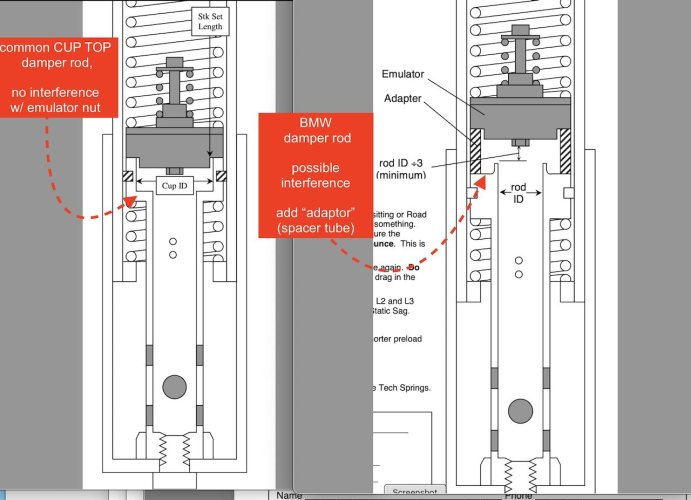gtgt_bangbang
New member
Read enough good to great things about Race Tech's Cartridge Emulators to add to Must-Have list.
Emulator is a spring-controlled check valve / flow controller which is inserted between the original (modified) damper rod and (stiffer, shorter) main suspension spring.
A cartridge kit "specific" for 36mm BMW tubes is ~ $220 from racetech direct , which seems a heck of a lot for what it is but I didn't spot any cheaper sources.
The PN is basically an indicator of diameter , the "33xx" being correct series for 36mm OD tubes,
and there is a less-specific kit that can be had for ~ $140 (genuine. ) which still seems a hecka lot , but enough less to take the leap.
I talked to MFG's tech rep who said the less-specific kit will work fine in the beemer (oi, have to make your own 1" spacer / bushing; easy do)
Will know more today but the "BMW" kit I think just added some short tube spacers to the box.
note - the RT springs came with a short length of stout plastic pipe, a little more sturdy than the usual hack of sched 40 3/4" PVC,
which should be long enough for the required distance pieces plus pre-loaders
Seems to be sufficient info on the MFG's site, and tuning/adjusting the cartridge is a very normal thing to do, (valve spring rate & settings, check valve port size/count),
to make the cheaper kit work jess fine
Emulator is a spring-controlled check valve / flow controller which is inserted between the original (modified) damper rod and (stiffer, shorter) main suspension spring.
A cartridge kit "specific" for 36mm BMW tubes is ~ $220 from racetech direct , which seems a heck of a lot for what it is but I didn't spot any cheaper sources.
The PN is basically an indicator of diameter , the "33xx" being correct series for 36mm OD tubes,
and there is a less-specific kit that can be had for ~ $140 (genuine. ) which still seems a hecka lot , but enough less to take the leap.
I talked to MFG's tech rep who said the less-specific kit will work fine in the beemer (oi, have to make your own 1" spacer / bushing; easy do)
Will know more today but the "BMW" kit I think just added some short tube spacers to the box.
note - the RT springs came with a short length of stout plastic pipe, a little more sturdy than the usual hack of sched 40 3/4" PVC,
which should be long enough for the required distance pieces plus pre-loaders
Seems to be sufficient info on the MFG's site, and tuning/adjusting the cartridge is a very normal thing to do, (valve spring rate & settings, check valve port size/count),
to make the cheaper kit work jess fine
Last edited:

 WHAT?!?! no, thats just a typo ! ) and some other baggage
WHAT?!?! no, thats just a typo ! ) and some other baggage